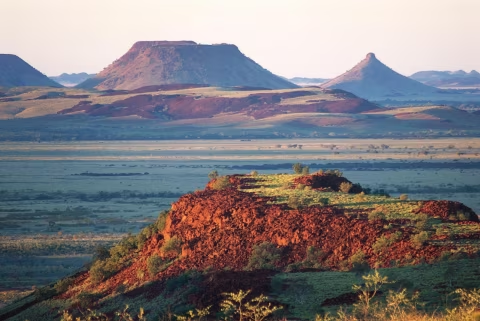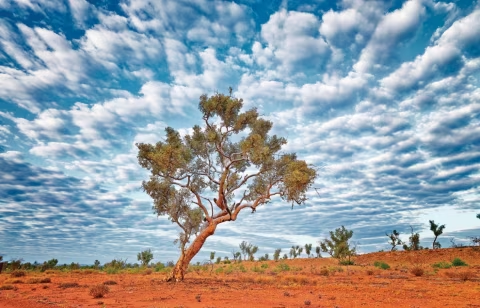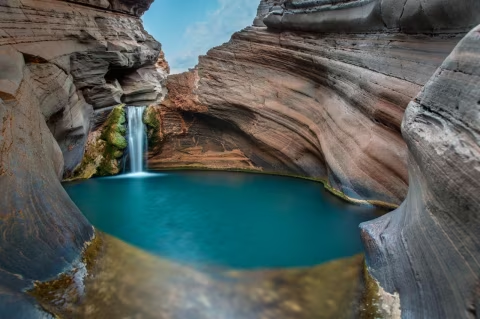Did You Know You Can Find Oysters in the WA Outback?

Oysters in the outback? Yep, and they’re topnotch, too. Take a bush tucker tour in the remote Pilbara region and begins to unlock the land’s many secrets.
Some 1500 kilometres north of Perth, in a part of the Pilbara better known for its gas plant than its gastronomic treasures, I devour an oyster so sweet I’m afraid I’ve been ruined for life. Affixed to a rock, this perfect specimen is served to me with a Bear Grylls-branded hunting knife and an encouraging smile from Ngarluma/Yindjibarndi man Clinton Walker, my guide for the next two days. As we hack away at the bivalves, the warm waters of Withnell Bay lapping at rocks speckled with the creamy gems, Clinton tells me we are near a traditional birthing site. Just imagine that. His family has been raising children in this dusty pocket of Western Australia for 50,000 years.
Even today, the Pilbara can be a tough place to live. Summer temps routinely climb into the mid-40s, it weathers cyclones and even lays claim to its very own species of death adder. I’ve braved all this for a private bush tucker/rock art expedition with Clinton’s Karratha company, Ngurrangga Tours, hoping to pick up some survival skills (lest I one day find myself stranded, in need of a fresh dozen).

His first tip? Forget the knife – the easiest way to prise open an oyster is with fistfuls of lit spinifex: hold the smouldering grass to the molluscs and they’ll slowly open to reveal their riches. Clinton’s smoked oysters, served with samphire, are a hit with chefs who do his tour (as is his goanna, which he reckons tastes a bit like chicken).
At 17, Clinton underwent initiation south of Roebourne, where he spent months living on country and learning from his community. He tells me about the process, which begins when the boys are painted with the burnt bark of a cork tree (to prevent sweating and keep the body cool) and ends with a swim one year later. Water is sacred – it belongs to the Rainbow Serpent – and to learn to respect it, the boys are not allowed to bathe in any natural source for 12 months.
“Growing up, I spent a lot of time going out on the country with Elders, listening and learning from them,” he says. “I knew there were a lot of things to see and do around here and I wanted to give tourists an opportunity to see the Pilbara the same way I did.” So five years ago, when the resources boom slowed – and accommodation in Karratha became more affordable – Clinton left his job with oil and gas company Woodside and established Ngurrangga Tours.
Today he runs daytrips and multi-day camping adventures for individuals and groups, the latter including overnight stays in Millstream Chichester National Park. His tours are popular with families and international travellers but most guests are, in fact, baby boomers who were never taught about Aboriginal culture at school. “People see the Pilbara as a mining district and I want to change that,” says Clinton. “But I also want to use tourism as a tool to help keep Aboriginal people’s cultural knowledge strong.”

As we scratch around the red dust on the outskirts of Karratha, sampling saltbush, samphire and native thyme, I’m reminded of the power food has to open up conversations, no matter where you are in the world. Before long, I feel I can ask Clinton anything. There are questions he can’t answer for cultural reasons but he’s not offended by my curiosity. With nothing off the table, I go for it: What about marriage – has that always existed? (“Yes, matches are traditionally arranged at birth.”) And what happens at a wedding? (“The groom presents his mother-in-law with a kangaroo.”) Really? Did you do that? (“No, I caught an emu – that’s even better.”) What’s your most favourite food in the world? (“Sea turtle, stir-fried and only eaten on special occasions.”)
Later, as we barrel down the highway, bound for Millstream Chichester National Park, an inland oasis about 120 kilometres south of Karratha, Clinton points out a distant falcon. “Did you see the spinifex pigeon in its talons?” he asks. What I saw was a bunch of rocks and termite mounds. But Clinton reads the landscape; nothing escapes his attention. Like the roo he spots partially hidden by a tree – the tuft of white on its belly apparently a dead giveaway. “It’s about looking for patterns,” he reminds me, “that’s when you spot difference.”
I’m surprised to learn that Clinton is only 36 – and not just because he’s already a grandfather. Maybe it’s his knowledge, maybe it’s the patience he shows as I fumble with the hunting knife, attempting to dig a bush onion out of the hard earth, but he seems much older than his years. When I tell him that, he says: “It’s because I have thousands of years of learning behind me – because I listen to my Elders.”
Sometimes an Elder will join the tour to check up on the “young pup” and Clinton hopes to employ others in the community as the business grows. “The majority of people here believe that I’m making a difference,” he says, “because I’m giving non-Aboriginal people a better understanding of our country and our culture so they can respect the land the same way we do.”
Yesterday, as we waded through the shallows on the Burrup Peninsula (Murujuga) – in waters teeming with mud crabs – Clinton told me that Ngarluma country is significant to all Aboriginal groups because a number of songlines start here. He shares one with me in the Yindjibarndi language – the story of a butcherbird. It’s beautiful, somewhere between a song and a chant. Each group has songlines that tell part of a Creation Story and the narrative is continued by neighbouring groups across the country. “It’s the original social media,” jokes Clinton.
I came to Karratha to learn about bush tucker but it’s the cultural discoveries that I find truly fascinating. Like the world’s largest collection of petroglyphs, which we explore at Murujuga National Park. I’ve seen rock art before but I’ve always felt a bit underwhelmed and with Clinton there to explain the works, I realise why: it’s like flicking through a book in another language – it might be nice to look at, it might be very old but it doesn’t really mean anything to you. This time, it’s different.

Image credit: Suzanne Long
Clinton points out an image of tracks made by two emus, one footprint twice the size of the other, carved at the end of the Ice Age. He believes the two are shown side by side as a way of recording the extinction of the megafauna and the arrival of the bird we know today.
The fall of light brings different etchings into view, unveiling new works as the sun dips and the seasons change. Clinton, who has grown up in these galleries, says he’s still discovering pieces in the million-plus collection, some of them among the oldest human creations in the world. In the 1970s and ’80s, many were destroyed to make way for the gasworks and Clinton has made it his life’s mission to protect what remains. “People understand why I want to protect it, because they’ve seen it from my eyes. It’s hard trying to protect something you know nothing about.”
As instructed, I look for patterns in the landscape and it doesn’t take long before I start to see things. Like a patch of burnt spinifex left by someone collecting resin, used for knife handles and binding spearheads. And the tracks out the front of the old homestead at Millstream Chichester National Park – evidence of domestic cattle gone wild. Looking up at the rock art, I make out the edges of a faint work, which appears to be some kind of spike. “What’s that one?” I ask. Clinton looks uncomfortable. “Let’s just say it’s a fertility symbol,” he replies, about as sheepish as I am smug.
Top image credit: Ingo Oeland
SEE ALSO: 13 Incredible Reasons to Visit the Kimberley



